400974 Clinical Teaching: Self-Reflection and Assessment Essay
VerifiedAdded on 2023/06/12
|13
|3848
|478
Essay
AI Summary
This essay presents a self-reflection and evaluation of a clinical teaching experience, focusing on a CPR training session for registered nurses. Utilizing Gibbs' reflective cycle, the author describes the teaching process, personal feelings, and a critical evaluation of the experience. The reflection identifies strengths such as creating a learner-centered environment and incorporating various learning styles, while also acknowledging weaknesses like time constraints for practical sessions. The essay analyzes the factors contributing to both successful and challenging aspects of the teaching, culminating in an action plan for future improvements. The student discusses session planning, teaching strategies, and cultural sensitivity, while also addressing the need for better time management in practical training scenarios. The ultimate goal is to enhance future clinical teaching performance through informed self-assessment and reflective practice.
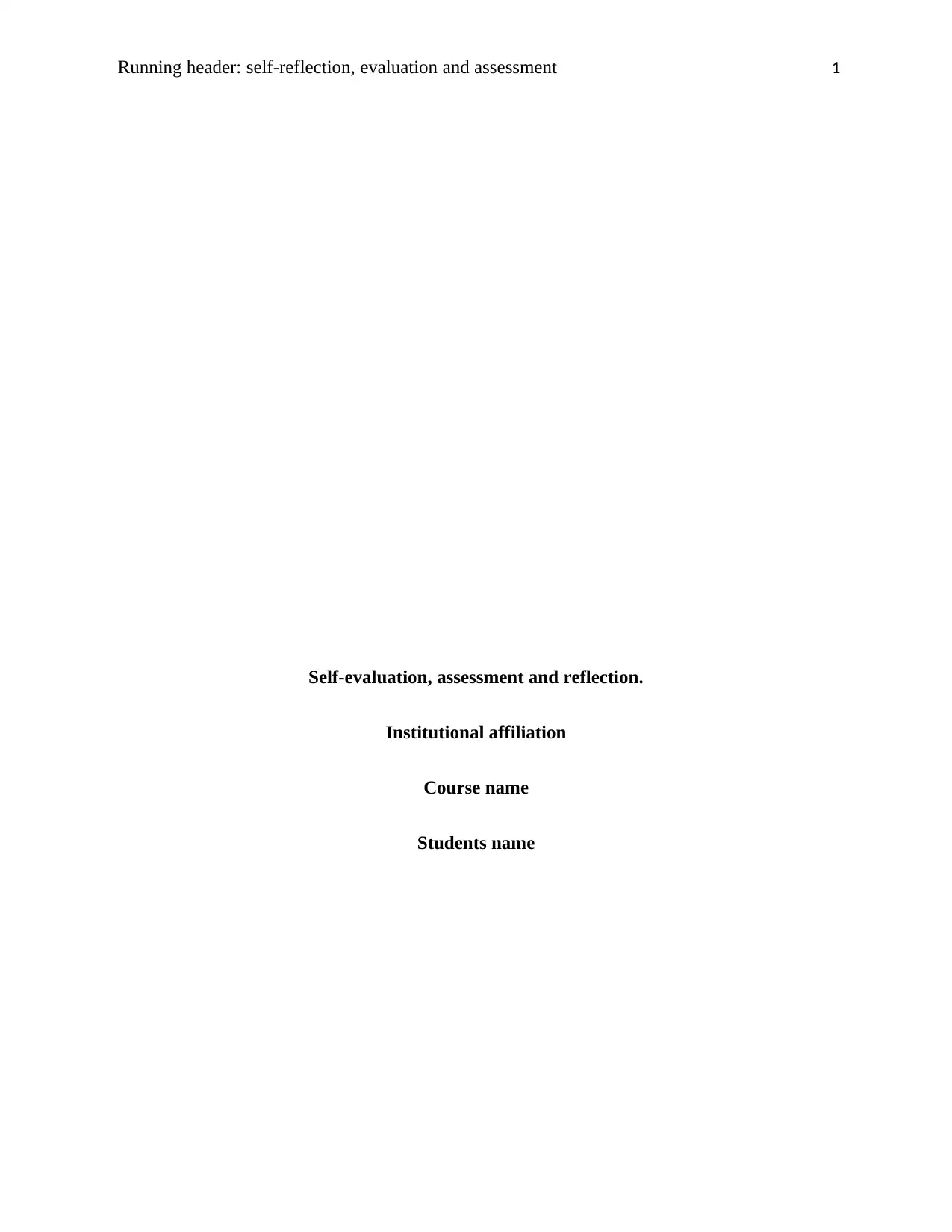
Running header: self-reflection, evaluation and assessment 1
Self-evaluation, assessment and reflection.
Institutional affiliation
Course name
Students name
Self-evaluation, assessment and reflection.
Institutional affiliation
Course name
Students name
Paraphrase This Document
Need a fresh take? Get an instant paraphrase of this document with our AI Paraphraser
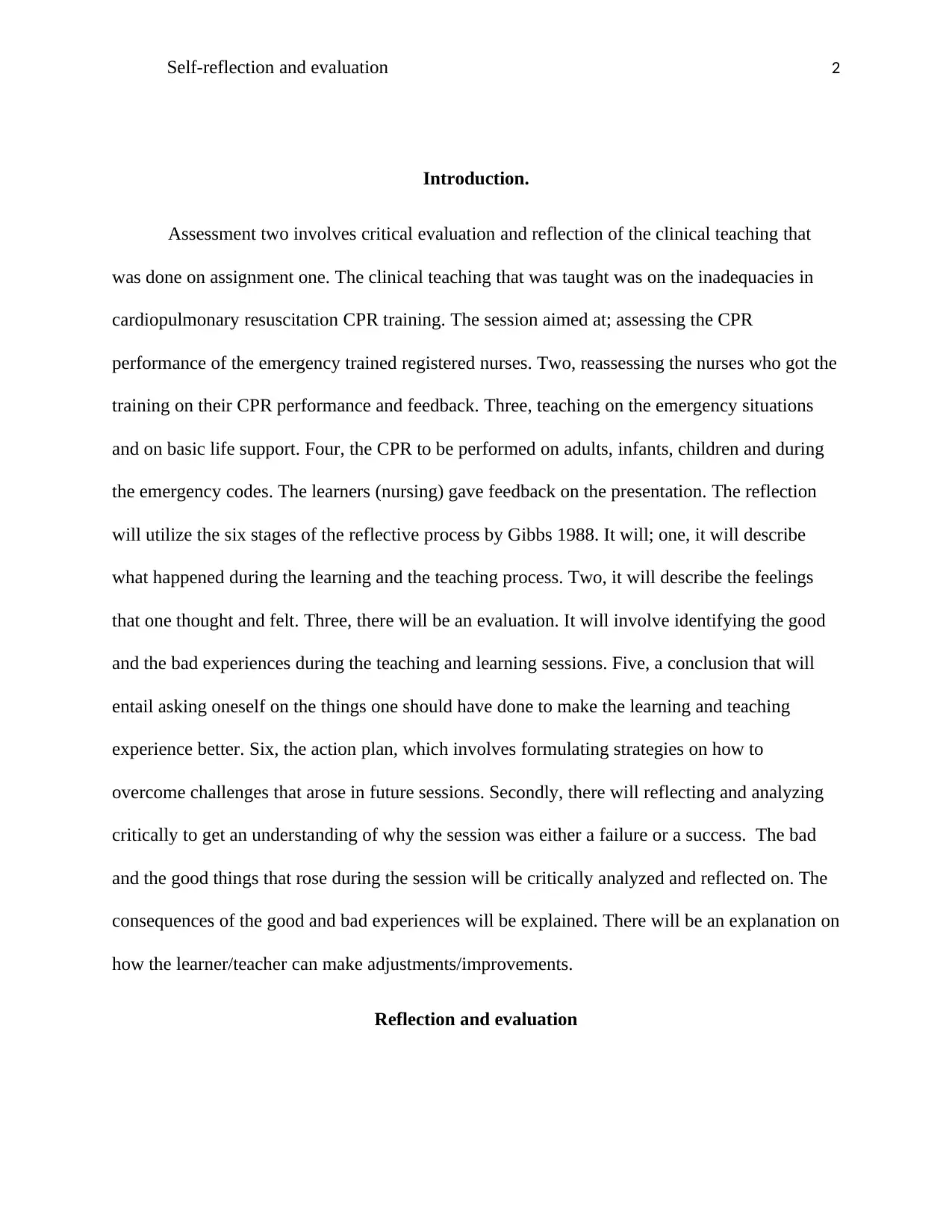
Self-reflection and evaluation 2
Introduction.
Assessment two involves critical evaluation and reflection of the clinical teaching that
was done on assignment one. The clinical teaching that was taught was on the inadequacies in
cardiopulmonary resuscitation CPR training. The session aimed at; assessing the CPR
performance of the emergency trained registered nurses. Two, reassessing the nurses who got the
training on their CPR performance and feedback. Three, teaching on the emergency situations
and on basic life support. Four, the CPR to be performed on adults, infants, children and during
the emergency codes. The learners (nursing) gave feedback on the presentation. The reflection
will utilize the six stages of the reflective process by Gibbs 1988. It will; one, it will describe
what happened during the learning and the teaching process. Two, it will describe the feelings
that one thought and felt. Three, there will be an evaluation. It will involve identifying the good
and the bad experiences during the teaching and learning sessions. Five, a conclusion that will
entail asking oneself on the things one should have done to make the learning and teaching
experience better. Six, the action plan, which involves formulating strategies on how to
overcome challenges that arose in future sessions. Secondly, there will reflecting and analyzing
critically to get an understanding of why the session was either a failure or a success. The bad
and the good things that rose during the session will be critically analyzed and reflected on. The
consequences of the good and bad experiences will be explained. There will be an explanation on
how the learner/teacher can make adjustments/improvements.
Reflection and evaluation
Introduction.
Assessment two involves critical evaluation and reflection of the clinical teaching that
was done on assignment one. The clinical teaching that was taught was on the inadequacies in
cardiopulmonary resuscitation CPR training. The session aimed at; assessing the CPR
performance of the emergency trained registered nurses. Two, reassessing the nurses who got the
training on their CPR performance and feedback. Three, teaching on the emergency situations
and on basic life support. Four, the CPR to be performed on adults, infants, children and during
the emergency codes. The learners (nursing) gave feedback on the presentation. The reflection
will utilize the six stages of the reflective process by Gibbs 1988. It will; one, it will describe
what happened during the learning and the teaching process. Two, it will describe the feelings
that one thought and felt. Three, there will be an evaluation. It will involve identifying the good
and the bad experiences during the teaching and learning sessions. Five, a conclusion that will
entail asking oneself on the things one should have done to make the learning and teaching
experience better. Six, the action plan, which involves formulating strategies on how to
overcome challenges that arose in future sessions. Secondly, there will reflecting and analyzing
critically to get an understanding of why the session was either a failure or a success. The bad
and the good things that rose during the session will be critically analyzed and reflected on. The
consequences of the good and bad experiences will be explained. There will be an explanation on
how the learner/teacher can make adjustments/improvements.
Reflection and evaluation
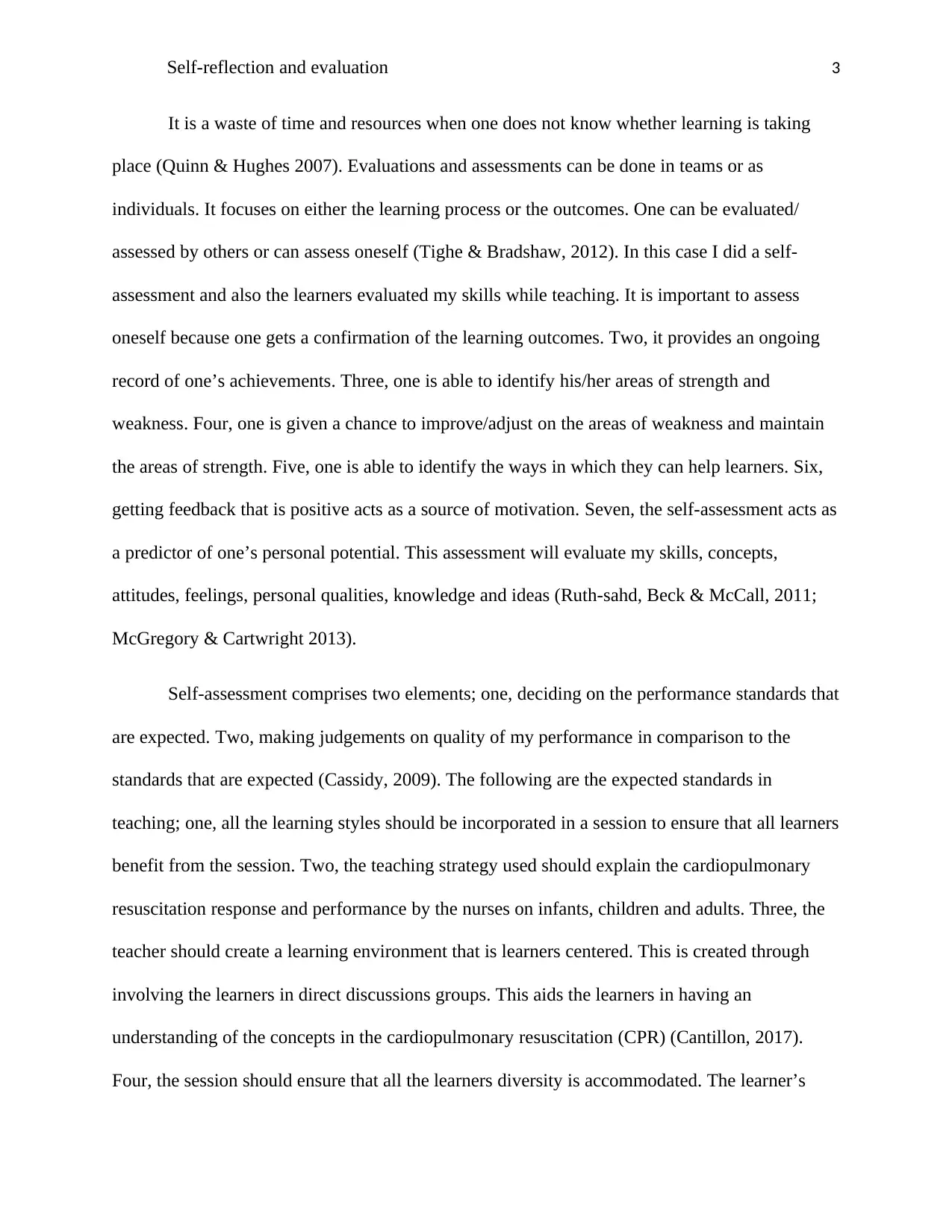
Self-reflection and evaluation 3
It is a waste of time and resources when one does not know whether learning is taking
place (Quinn & Hughes 2007). Evaluations and assessments can be done in teams or as
individuals. It focuses on either the learning process or the outcomes. One can be evaluated/
assessed by others or can assess oneself (Tighe & Bradshaw, 2012). In this case I did a self-
assessment and also the learners evaluated my skills while teaching. It is important to assess
oneself because one gets a confirmation of the learning outcomes. Two, it provides an ongoing
record of one’s achievements. Three, one is able to identify his/her areas of strength and
weakness. Four, one is given a chance to improve/adjust on the areas of weakness and maintain
the areas of strength. Five, one is able to identify the ways in which they can help learners. Six,
getting feedback that is positive acts as a source of motivation. Seven, the self-assessment acts as
a predictor of one’s personal potential. This assessment will evaluate my skills, concepts,
attitudes, feelings, personal qualities, knowledge and ideas (Ruth-sahd, Beck & McCall, 2011;
McGregory & Cartwright 2013).
Self-assessment comprises two elements; one, deciding on the performance standards that
are expected. Two, making judgements on quality of my performance in comparison to the
standards that are expected (Cassidy, 2009). The following are the expected standards in
teaching; one, all the learning styles should be incorporated in a session to ensure that all learners
benefit from the session. Two, the teaching strategy used should explain the cardiopulmonary
resuscitation response and performance by the nurses on infants, children and adults. Three, the
teacher should create a learning environment that is learners centered. This is created through
involving the learners in direct discussions groups. This aids the learners in having an
understanding of the concepts in the cardiopulmonary resuscitation (CPR) (Cantillon, 2017).
Four, the session should ensure that all the learners diversity is accommodated. The learner’s
It is a waste of time and resources when one does not know whether learning is taking
place (Quinn & Hughes 2007). Evaluations and assessments can be done in teams or as
individuals. It focuses on either the learning process or the outcomes. One can be evaluated/
assessed by others or can assess oneself (Tighe & Bradshaw, 2012). In this case I did a self-
assessment and also the learners evaluated my skills while teaching. It is important to assess
oneself because one gets a confirmation of the learning outcomes. Two, it provides an ongoing
record of one’s achievements. Three, one is able to identify his/her areas of strength and
weakness. Four, one is given a chance to improve/adjust on the areas of weakness and maintain
the areas of strength. Five, one is able to identify the ways in which they can help learners. Six,
getting feedback that is positive acts as a source of motivation. Seven, the self-assessment acts as
a predictor of one’s personal potential. This assessment will evaluate my skills, concepts,
attitudes, feelings, personal qualities, knowledge and ideas (Ruth-sahd, Beck & McCall, 2011;
McGregory & Cartwright 2013).
Self-assessment comprises two elements; one, deciding on the performance standards that
are expected. Two, making judgements on quality of my performance in comparison to the
standards that are expected (Cassidy, 2009). The following are the expected standards in
teaching; one, all the learning styles should be incorporated in a session to ensure that all learners
benefit from the session. Two, the teaching strategy used should explain the cardiopulmonary
resuscitation response and performance by the nurses on infants, children and adults. Three, the
teacher should create a learning environment that is learners centered. This is created through
involving the learners in direct discussions groups. This aids the learners in having an
understanding of the concepts in the cardiopulmonary resuscitation (CPR) (Cantillon, 2017).
Four, the session should ensure that all the learners diversity is accommodated. The learner’s
⊘ This is a preview!⊘
Do you want full access?
Subscribe today to unlock all pages.

Trusted by 1+ million students worldwide
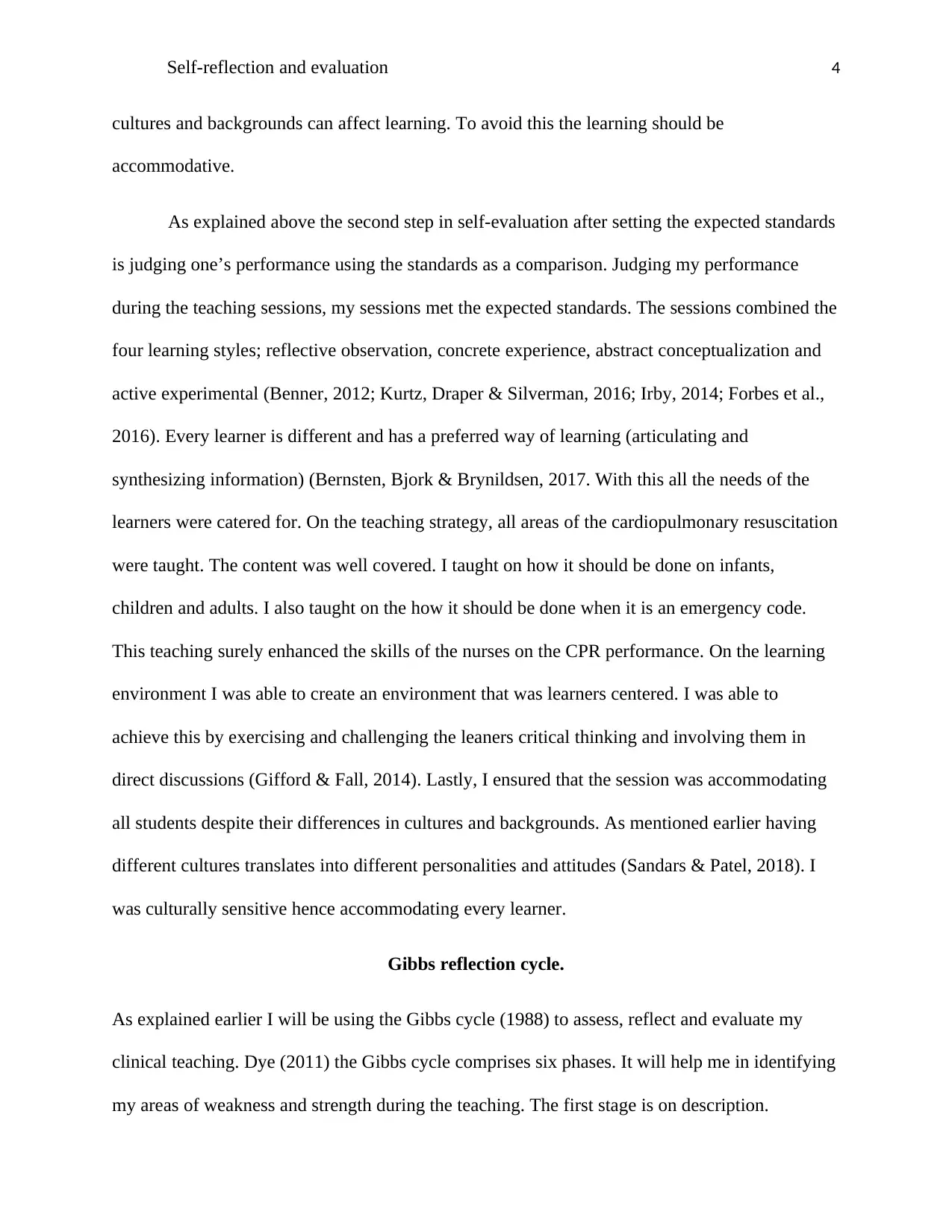
Self-reflection and evaluation 4
cultures and backgrounds can affect learning. To avoid this the learning should be
accommodative.
As explained above the second step in self-evaluation after setting the expected standards
is judging one’s performance using the standards as a comparison. Judging my performance
during the teaching sessions, my sessions met the expected standards. The sessions combined the
four learning styles; reflective observation, concrete experience, abstract conceptualization and
active experimental (Benner, 2012; Kurtz, Draper & Silverman, 2016; Irby, 2014; Forbes et al.,
2016). Every learner is different and has a preferred way of learning (articulating and
synthesizing information) (Bernsten, Bjork & Brynildsen, 2017. With this all the needs of the
learners were catered for. On the teaching strategy, all areas of the cardiopulmonary resuscitation
were taught. The content was well covered. I taught on how it should be done on infants,
children and adults. I also taught on the how it should be done when it is an emergency code.
This teaching surely enhanced the skills of the nurses on the CPR performance. On the learning
environment I was able to create an environment that was learners centered. I was able to
achieve this by exercising and challenging the leaners critical thinking and involving them in
direct discussions (Gifford & Fall, 2014). Lastly, I ensured that the session was accommodating
all students despite their differences in cultures and backgrounds. As mentioned earlier having
different cultures translates into different personalities and attitudes (Sandars & Patel, 2018). I
was culturally sensitive hence accommodating every learner.
Gibbs reflection cycle.
As explained earlier I will be using the Gibbs cycle (1988) to assess, reflect and evaluate my
clinical teaching. Dye (2011) the Gibbs cycle comprises six phases. It will help me in identifying
my areas of weakness and strength during the teaching. The first stage is on description.
cultures and backgrounds can affect learning. To avoid this the learning should be
accommodative.
As explained above the second step in self-evaluation after setting the expected standards
is judging one’s performance using the standards as a comparison. Judging my performance
during the teaching sessions, my sessions met the expected standards. The sessions combined the
four learning styles; reflective observation, concrete experience, abstract conceptualization and
active experimental (Benner, 2012; Kurtz, Draper & Silverman, 2016; Irby, 2014; Forbes et al.,
2016). Every learner is different and has a preferred way of learning (articulating and
synthesizing information) (Bernsten, Bjork & Brynildsen, 2017. With this all the needs of the
learners were catered for. On the teaching strategy, all areas of the cardiopulmonary resuscitation
were taught. The content was well covered. I taught on how it should be done on infants,
children and adults. I also taught on the how it should be done when it is an emergency code.
This teaching surely enhanced the skills of the nurses on the CPR performance. On the learning
environment I was able to create an environment that was learners centered. I was able to
achieve this by exercising and challenging the leaners critical thinking and involving them in
direct discussions (Gifford & Fall, 2014). Lastly, I ensured that the session was accommodating
all students despite their differences in cultures and backgrounds. As mentioned earlier having
different cultures translates into different personalities and attitudes (Sandars & Patel, 2018). I
was culturally sensitive hence accommodating every learner.
Gibbs reflection cycle.
As explained earlier I will be using the Gibbs cycle (1988) to assess, reflect and evaluate my
clinical teaching. Dye (2011) the Gibbs cycle comprises six phases. It will help me in identifying
my areas of weakness and strength during the teaching. The first stage is on description.
Paraphrase This Document
Need a fresh take? Get an instant paraphrase of this document with our AI Paraphraser
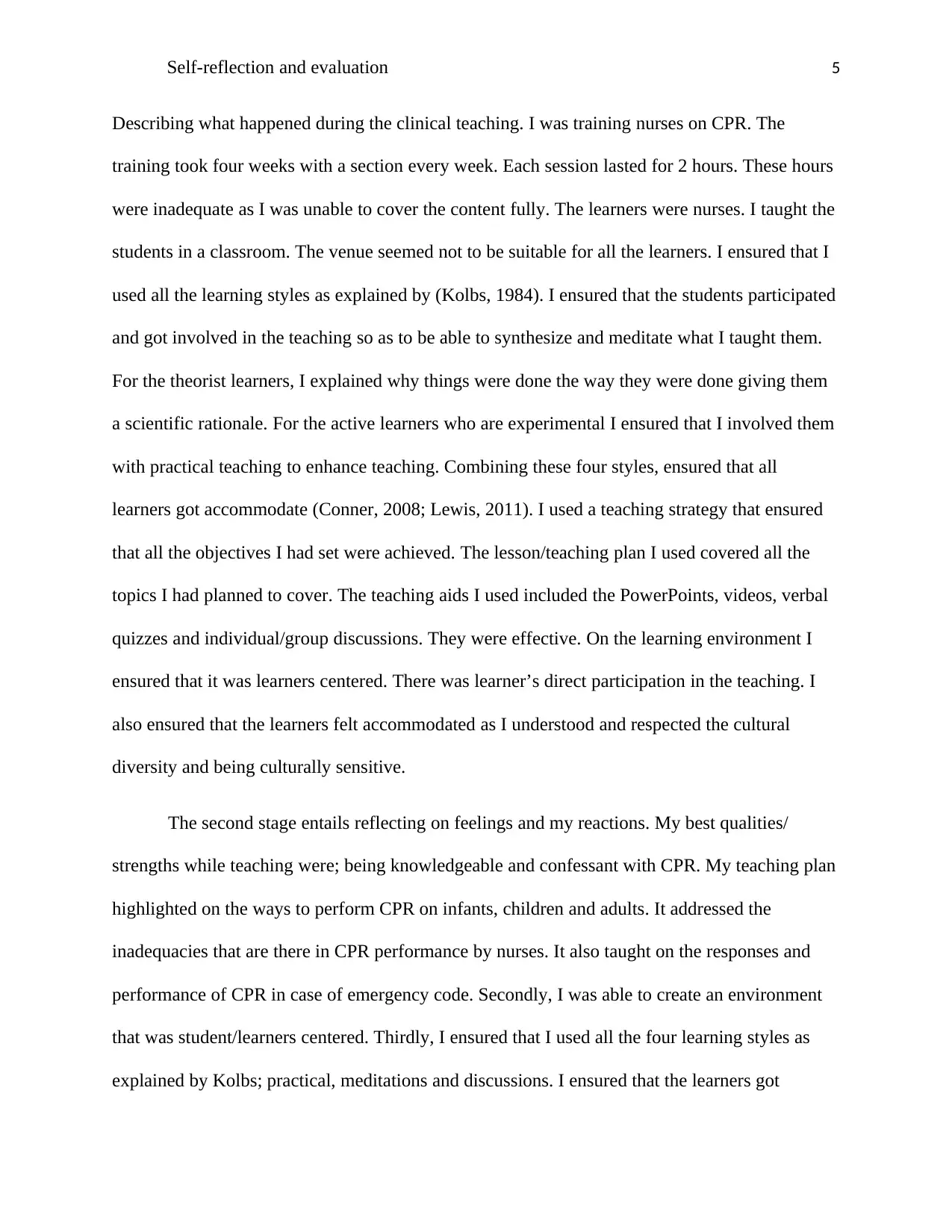
Self-reflection and evaluation 5
Describing what happened during the clinical teaching. I was training nurses on CPR. The
training took four weeks with a section every week. Each session lasted for 2 hours. These hours
were inadequate as I was unable to cover the content fully. The learners were nurses. I taught the
students in a classroom. The venue seemed not to be suitable for all the learners. I ensured that I
used all the learning styles as explained by (Kolbs, 1984). I ensured that the students participated
and got involved in the teaching so as to be able to synthesize and meditate what I taught them.
For the theorist learners, I explained why things were done the way they were done giving them
a scientific rationale. For the active learners who are experimental I ensured that I involved them
with practical teaching to enhance teaching. Combining these four styles, ensured that all
learners got accommodate (Conner, 2008; Lewis, 2011). I used a teaching strategy that ensured
that all the objectives I had set were achieved. The lesson/teaching plan I used covered all the
topics I had planned to cover. The teaching aids I used included the PowerPoints, videos, verbal
quizzes and individual/group discussions. They were effective. On the learning environment I
ensured that it was learners centered. There was learner’s direct participation in the teaching. I
also ensured that the learners felt accommodated as I understood and respected the cultural
diversity and being culturally sensitive.
The second stage entails reflecting on feelings and my reactions. My best qualities/
strengths while teaching were; being knowledgeable and confessant with CPR. My teaching plan
highlighted on the ways to perform CPR on infants, children and adults. It addressed the
inadequacies that are there in CPR performance by nurses. It also taught on the responses and
performance of CPR in case of emergency code. Secondly, I was able to create an environment
that was student/learners centered. Thirdly, I ensured that I used all the four learning styles as
explained by Kolbs; practical, meditations and discussions. I ensured that the learners got
Describing what happened during the clinical teaching. I was training nurses on CPR. The
training took four weeks with a section every week. Each session lasted for 2 hours. These hours
were inadequate as I was unable to cover the content fully. The learners were nurses. I taught the
students in a classroom. The venue seemed not to be suitable for all the learners. I ensured that I
used all the learning styles as explained by (Kolbs, 1984). I ensured that the students participated
and got involved in the teaching so as to be able to synthesize and meditate what I taught them.
For the theorist learners, I explained why things were done the way they were done giving them
a scientific rationale. For the active learners who are experimental I ensured that I involved them
with practical teaching to enhance teaching. Combining these four styles, ensured that all
learners got accommodate (Conner, 2008; Lewis, 2011). I used a teaching strategy that ensured
that all the objectives I had set were achieved. The lesson/teaching plan I used covered all the
topics I had planned to cover. The teaching aids I used included the PowerPoints, videos, verbal
quizzes and individual/group discussions. They were effective. On the learning environment I
ensured that it was learners centered. There was learner’s direct participation in the teaching. I
also ensured that the learners felt accommodated as I understood and respected the cultural
diversity and being culturally sensitive.
The second stage entails reflecting on feelings and my reactions. My best qualities/
strengths while teaching were; being knowledgeable and confessant with CPR. My teaching plan
highlighted on the ways to perform CPR on infants, children and adults. It addressed the
inadequacies that are there in CPR performance by nurses. It also taught on the responses and
performance of CPR in case of emergency code. Secondly, I was able to create an environment
that was student/learners centered. Thirdly, I ensured that I used all the four learning styles as
explained by Kolbs; practical, meditations and discussions. I ensured that the learners got

Self-reflection and evaluation 6
involved in the learning by asking them questions and clarifying and answering their questions.
Lastly, I was culturally sensitive which ensured that every learner felt accommodated.
My weaknesses during the clinical teaching were; one, not being able to cover all my
content in the two hours that the session had been allocated. It is a class that involves a lot of
practical sessions. Two hours were not enough. This means that some objectives/ skills that were
meant to be learnt by the learners were not achieved. Therefore, despite using a combination of
the four learning styles, the one on experimental/practical I underexploited it.
The third stage on the Gibbs reflection cycle is on evaluation. Identifying the good and
the bad experiences during the clinical teaching. The teaching experiences that were good
included; formulating a lesson plan that accommodated the objectives the learners were to learn.
Two, my teaching strategy utilized both the visual audio technologies. Three, I was also able to
utilize the four styles of learning by Kolbs although I did not maximize on the practical learning
style. Four, on the learning environment, I was able to create a learners centered environment by
involving the learners during the teaching. Five, I ensured that my sessions accommodated all the
learners by being cultural sensitive to the cultural diverse. The only bad experience was not
meeting the practical objectives of the session. The two hours were not enough to demonstrate
the practical aspect of the session successfully.
The fourth stage is on analyzing the situations (experiences) so as to make/bring sense on
the experiences. The success of the clinical teaching was the result of having a well-planned
teaching/lesson plan. The lesson plan I formulated covered the contents of the topic I was
addressing. The teaching aids I used made understanding easy for the learners and easy for me to
teach. Using the four styles of learning made it possible to accommodate all the students. As
mentioned earlier every student has a preferred way of learning. There was a challenge on the
involved in the learning by asking them questions and clarifying and answering their questions.
Lastly, I was culturally sensitive which ensured that every learner felt accommodated.
My weaknesses during the clinical teaching were; one, not being able to cover all my
content in the two hours that the session had been allocated. It is a class that involves a lot of
practical sessions. Two hours were not enough. This means that some objectives/ skills that were
meant to be learnt by the learners were not achieved. Therefore, despite using a combination of
the four learning styles, the one on experimental/practical I underexploited it.
The third stage on the Gibbs reflection cycle is on evaluation. Identifying the good and
the bad experiences during the clinical teaching. The teaching experiences that were good
included; formulating a lesson plan that accommodated the objectives the learners were to learn.
Two, my teaching strategy utilized both the visual audio technologies. Three, I was also able to
utilize the four styles of learning by Kolbs although I did not maximize on the practical learning
style. Four, on the learning environment, I was able to create a learners centered environment by
involving the learners during the teaching. Five, I ensured that my sessions accommodated all the
learners by being cultural sensitive to the cultural diverse. The only bad experience was not
meeting the practical objectives of the session. The two hours were not enough to demonstrate
the practical aspect of the session successfully.
The fourth stage is on analyzing the situations (experiences) so as to make/bring sense on
the experiences. The success of the clinical teaching was the result of having a well-planned
teaching/lesson plan. The lesson plan I formulated covered the contents of the topic I was
addressing. The teaching aids I used made understanding easy for the learners and easy for me to
teach. Using the four styles of learning made it possible to accommodate all the students. As
mentioned earlier every student has a preferred way of learning. There was a challenge on the
⊘ This is a preview!⊘
Do you want full access?
Subscribe today to unlock all pages.

Trusted by 1+ million students worldwide

Self-reflection and evaluation 7
practical aspect of the session. The time allocated was not sufficient. This means that the
learner’s needs were inadequately addressed.
The fifth stage is explaining what could have been done so as to have an easier teaching easier.
The clinical teaching, I did was clearly a success using the Gibbs reflection cycle as a guide to do
a self-assessment/ reflection. Most of the objectives were met, the teaching strategy I used made
it easier for the learners to synthesize and articulate information. It also made it easier for me to
teach. I created a conducive environment for the learners to learn as it was learners centered. I
made all the students feel accommodated by being culturally sensitivity by understanding there is
cultural diversity and it affects learning. Lastly, I utilized the four styles of learning so as to
accommodate all the students based on their preferred learning styles. The bad experiences were
as a result of lack of adequate time allocated for practical lessons. This made it hard to achieve
the objectives on practical aspect of the session.
The six (final stage) is on formulating an action plan to deal with bad situations that arose
during the clinical teaching so as to avoid such incidences in future or to be able to handle such
in future. The bad situation/experience was on the little time the class had to cover the practical
aspect of the sessions. The sessions major section is on the practical aspects. To ensure that this
was covered, I should have made sure that the teaching plan/lesson plan allocated more time on
this. This is a lesson well learnt and in future when tacked with such issue I will be able to tackle
it effectively.
Critical evaluation and analysis.
This section will entail an evaluation and analysis of all the experiences I had while
teaching in the clinical, both good and the bad situations/experiences. I will give an explain what
practical aspect of the session. The time allocated was not sufficient. This means that the
learner’s needs were inadequately addressed.
The fifth stage is explaining what could have been done so as to have an easier teaching easier.
The clinical teaching, I did was clearly a success using the Gibbs reflection cycle as a guide to do
a self-assessment/ reflection. Most of the objectives were met, the teaching strategy I used made
it easier for the learners to synthesize and articulate information. It also made it easier for me to
teach. I created a conducive environment for the learners to learn as it was learners centered. I
made all the students feel accommodated by being culturally sensitivity by understanding there is
cultural diversity and it affects learning. Lastly, I utilized the four styles of learning so as to
accommodate all the students based on their preferred learning styles. The bad experiences were
as a result of lack of adequate time allocated for practical lessons. This made it hard to achieve
the objectives on practical aspect of the session.
The six (final stage) is on formulating an action plan to deal with bad situations that arose
during the clinical teaching so as to avoid such incidences in future or to be able to handle such
in future. The bad situation/experience was on the little time the class had to cover the practical
aspect of the sessions. The sessions major section is on the practical aspects. To ensure that this
was covered, I should have made sure that the teaching plan/lesson plan allocated more time on
this. This is a lesson well learnt and in future when tacked with such issue I will be able to tackle
it effectively.
Critical evaluation and analysis.
This section will entail an evaluation and analysis of all the experiences I had while
teaching in the clinical, both good and the bad situations/experiences. I will give an explain what
Paraphrase This Document
Need a fresh take? Get an instant paraphrase of this document with our AI Paraphraser

Self-reflection and evaluation 8
led to these outcomes, the influencers and the consequences of this to the ultimate outcome. In
this the ultimate outcome is my performance during the clinical teaching. I will give an
explanation on how I contributed to the bad experiences. I will also describe and explain how
others influenced the sessions to have a bad situation/experience. I will continue with an
explanation on how I reacted to both the positive and the negative feedback from the learners
who assessed me. Lastly, I will mention the things I will do differently if I was to redo the
session again. Was my session evaluated well? I will answer that question.
As mentioned earlier the clinical teaching was a total success because; one, I had a lesson
plan that was well planned. In teaching, a lesson plan is very important as it aids the teacher in
managing time and it is a tool used when reflecting and evaluating a session (Pritchard, 2008;
Thorners, 2009). I formulated the lesson plan through evaluating the learners needs. I used the
objectives I had formulated for the class to come up with a well-planned lesson plan. I also
considered the location I was going to teach from and the accessibility to computers and internet.
This gave me a guideline on the type of the teaching aids to use. the teaching plan gave me a tool
that I am using in assessing myself and assessing my learners (Knowles, 2015; Mujis &
Reynolds, 2016; Surgenor, 2010). This acts as a boost to my confidence in clinical teaching.
Secondly, my clinical teaching was a success as I achieved most of the objectives I had
set. I informed the learners on my expectations from them and their expectations from me by the
end of the lesson (Knowles, 2015; Mujis & Reynolds, 2016; Surgenor, 2010). The purpose of
setting objectives is to create a guideline on the content to teach. It also clarifies on the purpose
of teaching the session. The objective helps in determining the successfulness of the session I
taught.
led to these outcomes, the influencers and the consequences of this to the ultimate outcome. In
this the ultimate outcome is my performance during the clinical teaching. I will give an
explanation on how I contributed to the bad experiences. I will also describe and explain how
others influenced the sessions to have a bad situation/experience. I will continue with an
explanation on how I reacted to both the positive and the negative feedback from the learners
who assessed me. Lastly, I will mention the things I will do differently if I was to redo the
session again. Was my session evaluated well? I will answer that question.
As mentioned earlier the clinical teaching was a total success because; one, I had a lesson
plan that was well planned. In teaching, a lesson plan is very important as it aids the teacher in
managing time and it is a tool used when reflecting and evaluating a session (Pritchard, 2008;
Thorners, 2009). I formulated the lesson plan through evaluating the learners needs. I used the
objectives I had formulated for the class to come up with a well-planned lesson plan. I also
considered the location I was going to teach from and the accessibility to computers and internet.
This gave me a guideline on the type of the teaching aids to use. the teaching plan gave me a tool
that I am using in assessing myself and assessing my learners (Knowles, 2015; Mujis &
Reynolds, 2016; Surgenor, 2010). This acts as a boost to my confidence in clinical teaching.
Secondly, my clinical teaching was a success as I achieved most of the objectives I had
set. I informed the learners on my expectations from them and their expectations from me by the
end of the lesson (Knowles, 2015; Mujis & Reynolds, 2016; Surgenor, 2010). The purpose of
setting objectives is to create a guideline on the content to teach. It also clarifies on the purpose
of teaching the session. The objective helps in determining the successfulness of the session I
taught.
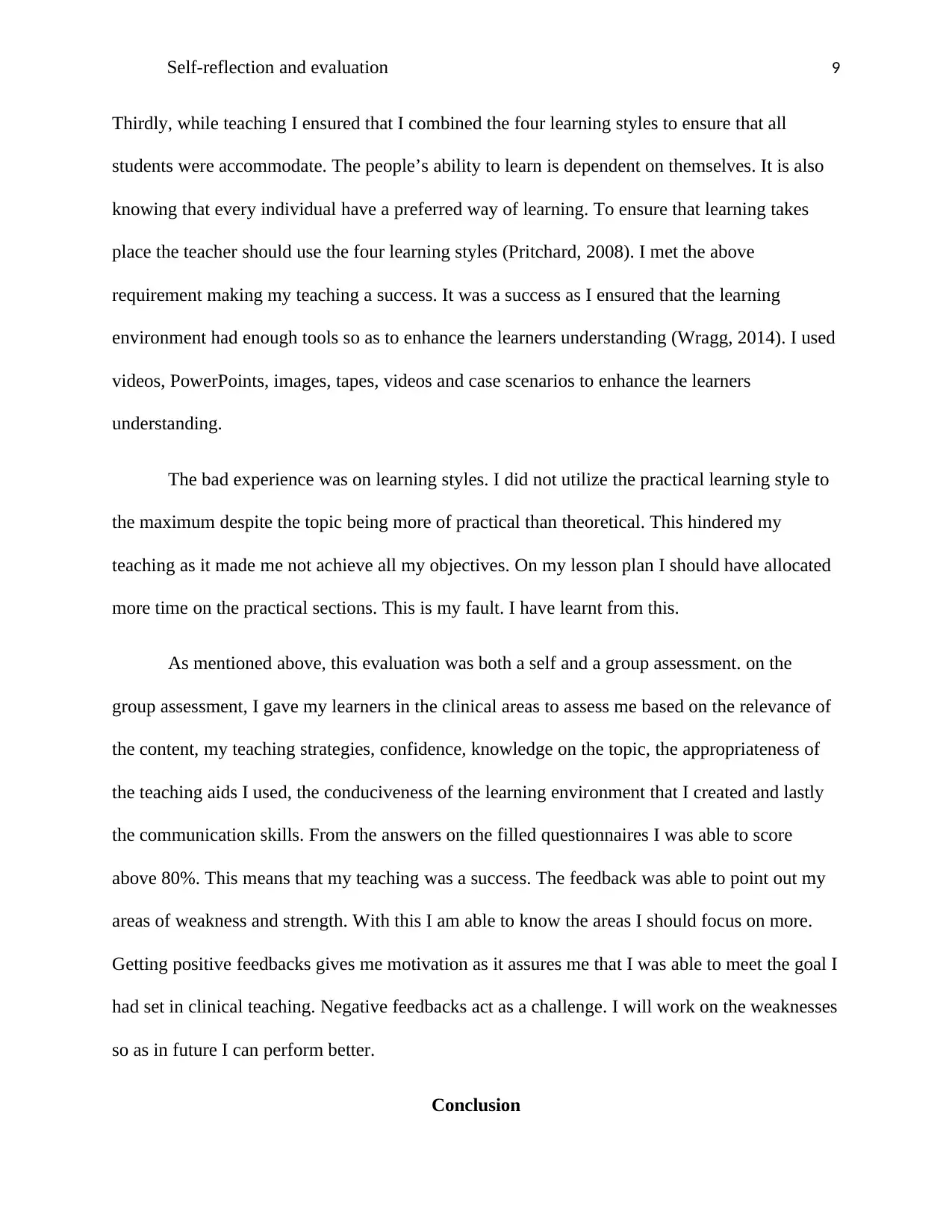
Self-reflection and evaluation 9
Thirdly, while teaching I ensured that I combined the four learning styles to ensure that all
students were accommodate. The people’s ability to learn is dependent on themselves. It is also
knowing that every individual have a preferred way of learning. To ensure that learning takes
place the teacher should use the four learning styles (Pritchard, 2008). I met the above
requirement making my teaching a success. It was a success as I ensured that the learning
environment had enough tools so as to enhance the learners understanding (Wragg, 2014). I used
videos, PowerPoints, images, tapes, videos and case scenarios to enhance the learners
understanding.
The bad experience was on learning styles. I did not utilize the practical learning style to
the maximum despite the topic being more of practical than theoretical. This hindered my
teaching as it made me not achieve all my objectives. On my lesson plan I should have allocated
more time on the practical sections. This is my fault. I have learnt from this.
As mentioned above, this evaluation was both a self and a group assessment. on the
group assessment, I gave my learners in the clinical areas to assess me based on the relevance of
the content, my teaching strategies, confidence, knowledge on the topic, the appropriateness of
the teaching aids I used, the conduciveness of the learning environment that I created and lastly
the communication skills. From the answers on the filled questionnaires I was able to score
above 80%. This means that my teaching was a success. The feedback was able to point out my
areas of weakness and strength. With this I am able to know the areas I should focus on more.
Getting positive feedbacks gives me motivation as it assures me that I was able to meet the goal I
had set in clinical teaching. Negative feedbacks act as a challenge. I will work on the weaknesses
so as in future I can perform better.
Conclusion
Thirdly, while teaching I ensured that I combined the four learning styles to ensure that all
students were accommodate. The people’s ability to learn is dependent on themselves. It is also
knowing that every individual have a preferred way of learning. To ensure that learning takes
place the teacher should use the four learning styles (Pritchard, 2008). I met the above
requirement making my teaching a success. It was a success as I ensured that the learning
environment had enough tools so as to enhance the learners understanding (Wragg, 2014). I used
videos, PowerPoints, images, tapes, videos and case scenarios to enhance the learners
understanding.
The bad experience was on learning styles. I did not utilize the practical learning style to
the maximum despite the topic being more of practical than theoretical. This hindered my
teaching as it made me not achieve all my objectives. On my lesson plan I should have allocated
more time on the practical sections. This is my fault. I have learnt from this.
As mentioned above, this evaluation was both a self and a group assessment. on the
group assessment, I gave my learners in the clinical areas to assess me based on the relevance of
the content, my teaching strategies, confidence, knowledge on the topic, the appropriateness of
the teaching aids I used, the conduciveness of the learning environment that I created and lastly
the communication skills. From the answers on the filled questionnaires I was able to score
above 80%. This means that my teaching was a success. The feedback was able to point out my
areas of weakness and strength. With this I am able to know the areas I should focus on more.
Getting positive feedbacks gives me motivation as it assures me that I was able to meet the goal I
had set in clinical teaching. Negative feedbacks act as a challenge. I will work on the weaknesses
so as in future I can perform better.
Conclusion
⊘ This is a preview!⊘
Do you want full access?
Subscribe today to unlock all pages.

Trusted by 1+ million students worldwide
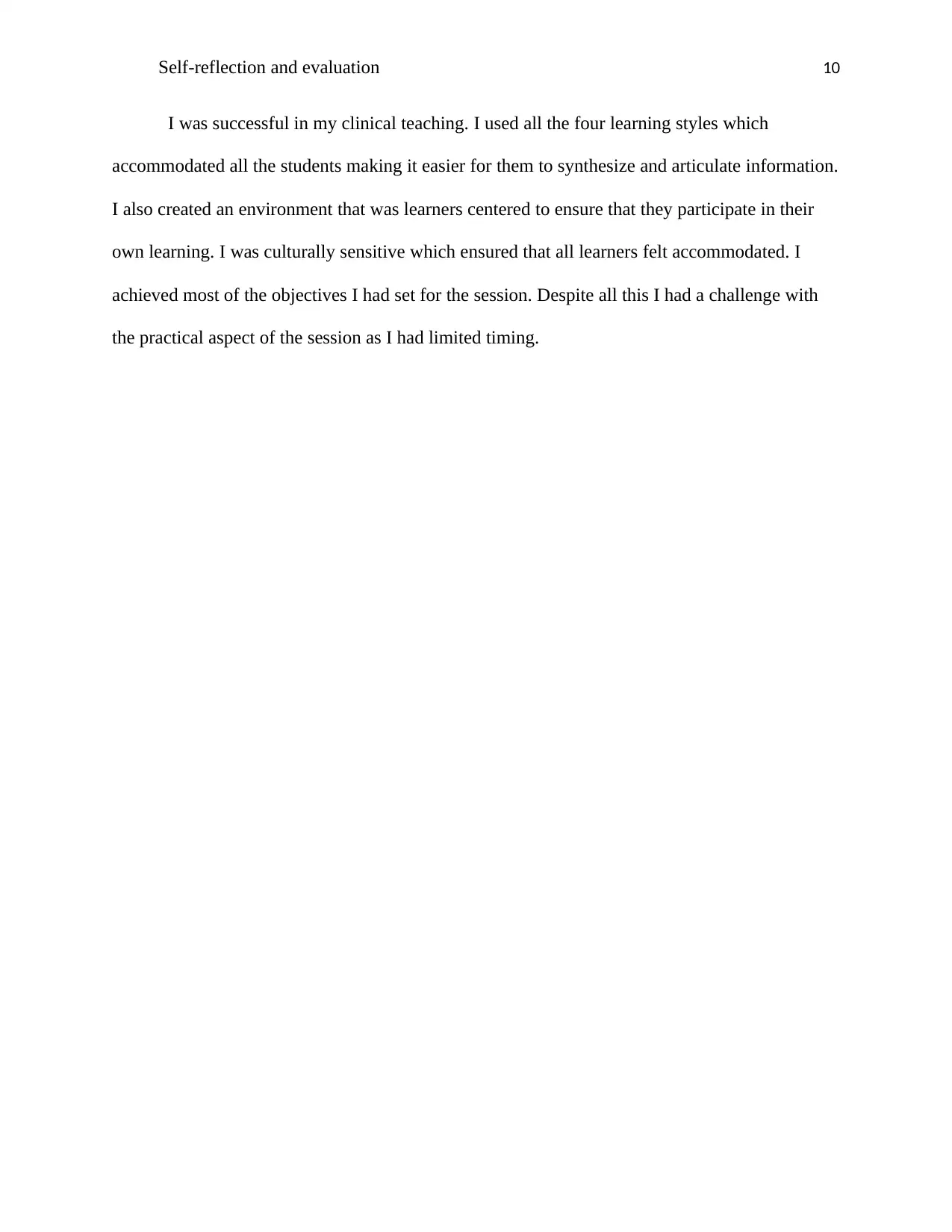
Self-reflection and evaluation 10
I was successful in my clinical teaching. I used all the four learning styles which
accommodated all the students making it easier for them to synthesize and articulate information.
I also created an environment that was learners centered to ensure that they participate in their
own learning. I was culturally sensitive which ensured that all learners felt accommodated. I
achieved most of the objectives I had set for the session. Despite all this I had a challenge with
the practical aspect of the session as I had limited timing.
I was successful in my clinical teaching. I used all the four learning styles which
accommodated all the students making it easier for them to synthesize and articulate information.
I also created an environment that was learners centered to ensure that they participate in their
own learning. I was culturally sensitive which ensured that all learners felt accommodated. I
achieved most of the objectives I had set for the session. Despite all this I had a challenge with
the practical aspect of the session as I had limited timing.
Paraphrase This Document
Need a fresh take? Get an instant paraphrase of this document with our AI Paraphraser

Self-reflection and evaluation 11
References
Khan, B. A., Ali, F., Vazir, N., Barolia, R., & Rehan, S. (2012). Students' perceptions of clinical
teaching and learning strategies: A Pakistani perspective. Nurse Education Today, 32(1),
85-90.
Benner, P. (2012). Educating nurses: A call for radical transformation—how far have we
come? Journal of Nursing Education, 51(4), 183-184.
Berntsen, K., Bjørk, I. T., & Brynildsen, G. (2017). Nursing Students’ Clinical Learning
Environment in Norwegian Nursing Homes: Lack of Innovative Teaching and Learning
Strategies. Open Journal of Nursing, 7(08), 949.
Bourgeois, S., Drayton, N., & Brown, A. M. (2011). An innovative model of supportive clinical
teaching and learning for undergraduate nursing students: The cluster model. Nurse
Education in Practice, 11(2), 114-118.
Cantillon, P. (2017). ABC of Learning and Teaching in Medicine. NY, John Wiley & Sons.
Cassidy, S., (2009). Subjective and the valid assessment of pre-registration student nurse clinical
learning outcomes. Nurse Education Today 29, 33-39.
Conner, M. L. (2008). Learning Style Assessment. retrieved on 20th-4- 2017 ;
http://agelesslearner.com/assess/learningstyle.html
Cowan D., Wilson, J., Norman I., (2015). A European survey of general nurses’ self-assessment
of competence. Nurse Education Today. 27, 452-458.
Dunne, R., Wragg, E., (2009). Learning styles. Effective teaching. 5, 89-99.
References
Khan, B. A., Ali, F., Vazir, N., Barolia, R., & Rehan, S. (2012). Students' perceptions of clinical
teaching and learning strategies: A Pakistani perspective. Nurse Education Today, 32(1),
85-90.
Benner, P. (2012). Educating nurses: A call for radical transformation—how far have we
come? Journal of Nursing Education, 51(4), 183-184.
Berntsen, K., Bjørk, I. T., & Brynildsen, G. (2017). Nursing Students’ Clinical Learning
Environment in Norwegian Nursing Homes: Lack of Innovative Teaching and Learning
Strategies. Open Journal of Nursing, 7(08), 949.
Bourgeois, S., Drayton, N., & Brown, A. M. (2011). An innovative model of supportive clinical
teaching and learning for undergraduate nursing students: The cluster model. Nurse
Education in Practice, 11(2), 114-118.
Cantillon, P. (2017). ABC of Learning and Teaching in Medicine. NY, John Wiley & Sons.
Cassidy, S., (2009). Subjective and the valid assessment of pre-registration student nurse clinical
learning outcomes. Nurse Education Today 29, 33-39.
Conner, M. L. (2008). Learning Style Assessment. retrieved on 20th-4- 2017 ;
http://agelesslearner.com/assess/learningstyle.html
Cowan D., Wilson, J., Norman I., (2015). A European survey of general nurses’ self-assessment
of competence. Nurse Education Today. 27, 452-458.
Dunne, R., Wragg, E., (2009). Learning styles. Effective teaching. 5, 89-99.
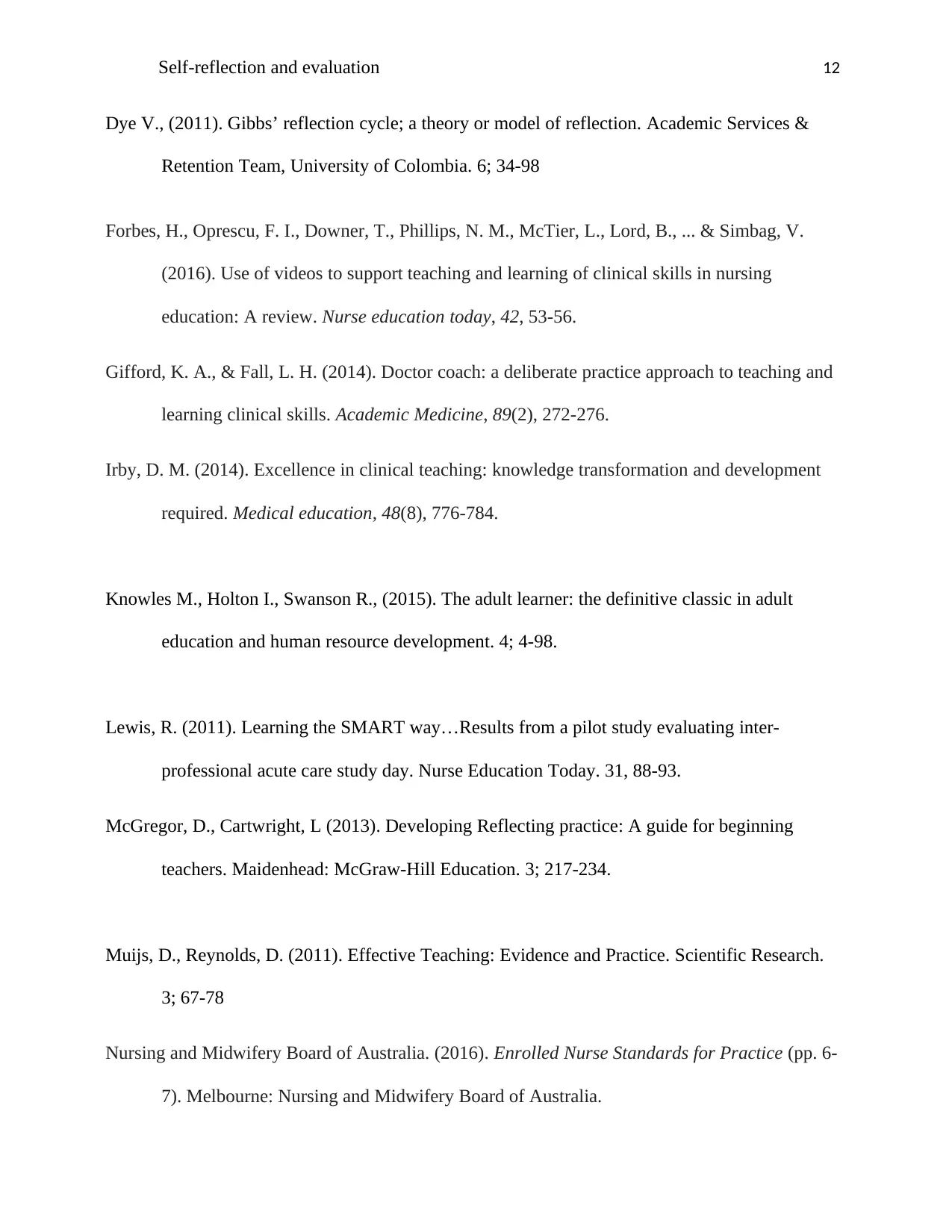
Self-reflection and evaluation 12
Dye V., (2011). Gibbs’ reflection cycle; a theory or model of reflection. Academic Services &
Retention Team, University of Colombia. 6; 34-98
Forbes, H., Oprescu, F. I., Downer, T., Phillips, N. M., McTier, L., Lord, B., ... & Simbag, V.
(2016). Use of videos to support teaching and learning of clinical skills in nursing
education: A review. Nurse education today, 42, 53-56.
Gifford, K. A., & Fall, L. H. (2014). Doctor coach: a deliberate practice approach to teaching and
learning clinical skills. Academic Medicine, 89(2), 272-276.
Irby, D. M. (2014). Excellence in clinical teaching: knowledge transformation and development
required. Medical education, 48(8), 776-784.
Knowles M., Holton I., Swanson R., (2015). The adult learner: the definitive classic in adult
education and human resource development. 4; 4-98.
Lewis, R. (2011). Learning the SMART way…Results from a pilot study evaluating inter-
professional acute care study day. Nurse Education Today. 31, 88-93.
McGregor, D., Cartwright, L (2013). Developing Reflecting practice: A guide for beginning
teachers. Maidenhead: McGraw-Hill Education. 3; 217-234.
Muijs, D., Reynolds, D. (2011). Effective Teaching: Evidence and Practice. Scientific Research.
3; 67-78
Nursing and Midwifery Board of Australia. (2016). Enrolled Nurse Standards for Practice (pp. 6-
7). Melbourne: Nursing and Midwifery Board of Australia.
Dye V., (2011). Gibbs’ reflection cycle; a theory or model of reflection. Academic Services &
Retention Team, University of Colombia. 6; 34-98
Forbes, H., Oprescu, F. I., Downer, T., Phillips, N. M., McTier, L., Lord, B., ... & Simbag, V.
(2016). Use of videos to support teaching and learning of clinical skills in nursing
education: A review. Nurse education today, 42, 53-56.
Gifford, K. A., & Fall, L. H. (2014). Doctor coach: a deliberate practice approach to teaching and
learning clinical skills. Academic Medicine, 89(2), 272-276.
Irby, D. M. (2014). Excellence in clinical teaching: knowledge transformation and development
required. Medical education, 48(8), 776-784.
Knowles M., Holton I., Swanson R., (2015). The adult learner: the definitive classic in adult
education and human resource development. 4; 4-98.
Lewis, R. (2011). Learning the SMART way…Results from a pilot study evaluating inter-
professional acute care study day. Nurse Education Today. 31, 88-93.
McGregor, D., Cartwright, L (2013). Developing Reflecting practice: A guide for beginning
teachers. Maidenhead: McGraw-Hill Education. 3; 217-234.
Muijs, D., Reynolds, D. (2011). Effective Teaching: Evidence and Practice. Scientific Research.
3; 67-78
Nursing and Midwifery Board of Australia. (2016). Enrolled Nurse Standards for Practice (pp. 6-
7). Melbourne: Nursing and Midwifery Board of Australia.
⊘ This is a preview!⊘
Do you want full access?
Subscribe today to unlock all pages.

Trusted by 1+ million students worldwide
1 out of 13
Related Documents
Your All-in-One AI-Powered Toolkit for Academic Success.
+13062052269
info@desklib.com
Available 24*7 on WhatsApp / Email
![[object Object]](/_next/static/media/star-bottom.7253800d.svg)
Unlock your academic potential
Copyright © 2020–2025 A2Z Services. All Rights Reserved. Developed and managed by ZUCOL.





